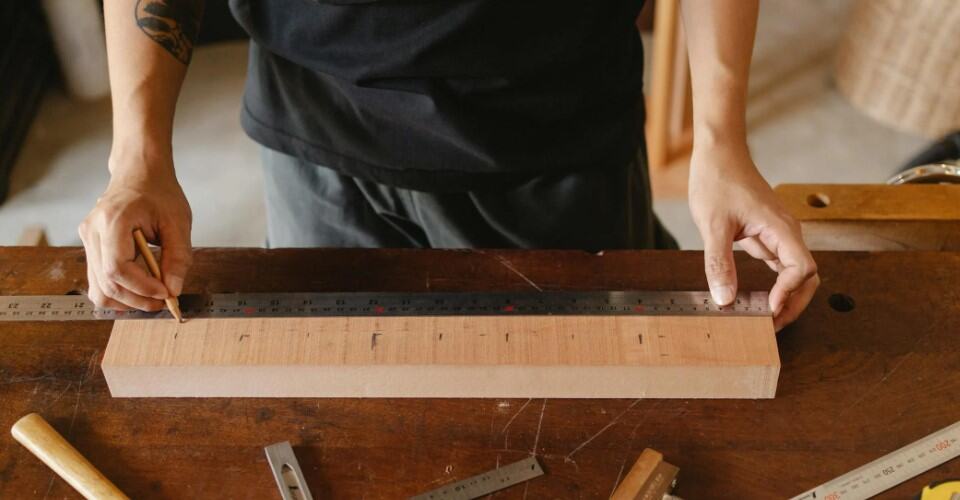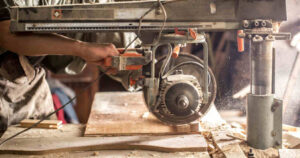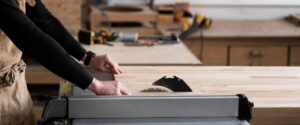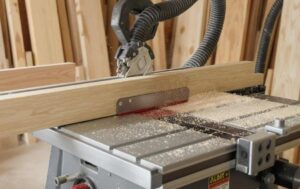Introduction
The table saw is one of the most powerful tools in the workshop. But if you’re not careful, it can also be very dangerous. So, if used correctly, it will be your best assistant.
Every year, thousands of woodworkers get injured by table saws, most of them because they don’t follow a few simple safety rules. Not only is it for your safety, but taking care of your saw will also help you make more accurate cuts, reduce unnecessary hassle, and help your expensive machine last for many years. So, it’s important to learn to use it properly.
Here, you will learn everything about table saw safety and care—from daily small precautions to advanced maintenance tips. This will make your work safer, easier, and smoother.
Table of Contents
Understanding Table Saw Basics
Before you worry about safety, take a moment to learn how a table saw actually works. If you don’t have a table saw, you can learn how to safely use a circular saw instead. When you understand the types and parts, it will be easier to choose the right saw, catch problems early, and maintain the machine properly.
Table Saw Types:
Cabinet Saws: Heavy-duty, enclosed motor, precise cuts, ideal for professional workshops.
Contractor Saws: Portable, open base, moderate power, good for home use.
Hybrid Saws: Mix of contractor and cabinet saw features, quieter motor, suitable for hobbyists.
Table Saw Safety Features You Should Know

Modern table saws have technology that helps reduce risk. So, learn about the features your saw has and use them.
Blade Guard
This clear cover over the blade is really useful. It keeps your fingers away from the blade and helps control sawdust. Always use it if possible.
Riving Knife
The riving knife is located just behind the blade and moves with the blade, ensuring that it always maintains the correct position. It prevents wood from getting stuck in the blade, which helps stop binding and kickback. Since it adjusts with the blade’s height and angle, it’s safer and more effective than a regular splitter.
Splitter
The splitter sits just behind the blade, but unlike the riving knife, it doesn’t move with the blade. Its work is to keep the pieces of wood apart while cutting, so that the blade doesn’t get stuck. Since it doesn’t move with the blade, it doesn’t always stay in the right position. So it’s a little less safe than the riving knife.
Anti-Kickback Pawls
The “Anti-kickback pawls” are small safety devices that hold the wood while using the saw. They make sure the wood doesn’t suddenly jump back toward you. This reduces kickback while cutting and makes the work much safer.
Push Sticks / Push Blocks
When cutting narrow pieces of wood, then it is important to use a push stick or push block. This will help push the wood forward while keeping your fingers safely away from the blade, reducing the risk of cutting or injuring your hands.
Flesh-Detection Technology
Flesh-sensing technology is a modern safety feature that immediately detects when the blade of a table saw touches your skin.
Imagine you are working and suddenly your hand touches the blade. With a normal blade, this could have caused a major accident, but with a system like SawStop, there’s no need to worry. Because as soon as the blade touches your skin, it senses the change in electrical signal and stops instantly using an aluminum brake—in just 5 milliseconds.
Magnetic Switches
A magnetic switch is a safety feature. Suppose, suddenly, the circuit breaker trips or the power goes out while you are working. With a normal saw, it can suddenly turn on when the power comes back on, causing an accident. But with a magnetic switch, there is nothing to worry about, because it automatically turns off the power to the saw. As a result, even if the power comes back on, the saw does not turn on suddenly, and there is no risk of cutting your hands or fingers.
Emergency Paddle Switches
The emergency paddle switches are big and simple to reach. If something goes wrong during a cut, you can press them with your hand or even your knee to stop the saw immediately.
Essential Table Saw Safety Rules
Proper Setup & Work Area
- Stable, level surface.
- Ensure good lighting and enough space around the saw.
- Keep the floor clear of debris to avoid tripping hazards.
Using Safety Gear
- Safety glasses (protect from flying debris).
- Hearing protection (table saws are loud).
- Dust mask or respirator (especially when cutting treated wood).
- Non-slip footwear (for steady footing).
- Avoid loose clothing, jewelry, or gloves that can get caught in the blade.
Correct Cutting Techniques
- Always stand to the side of the blade, rather than directly behind it.
- Keep your hands at least 6 inches away from the blade.
- Use push sticks, featherboards, and push blocks when working with small or narrow stock.
- Never try to cut freehand; always use a fence or miter gauge for control.
Kickback Prevention
Kickback happens when the wood is forced back towards you. Follow some simple safety precautions to prevent this :
- Keep the riving knife or splitter in place.
- Maintain firm, steady pressure when feeding stock.
- Never cut warped or twisted lumber.
- Do not stand in the direct line of the blade.
Blade Guard & Riving Knife Usage
- Whenever possible, always keep the blade guard in place. It’s the easiest way to keep your fingers safe.
- Ensure the riving knife is aligned with the blade.
- If you remove safety features for a specific cut, replace them immediately after finishing.
Common Hazards and How to Avoid Them
The biggest danger when using a table saw is kickback. This means the wood will suddenly get stuck in the blade and come flying at you. To avoid this problem, always set the riving knife and fence correctly.
Another common mistake people make is reaching their hands too close to the blade or trying to make a freehand cut. Believe me, this is the most likely happen of injury. So always use a guide.
The risks don’t end there. Touching a hot blade can burn you, and flying wood pieces can cause injuries. Imagine if the board is crooked? Then it could get caught in the blade and cause kickback. So, always check that the wood is straight before cutting.
The scariest thing is—85% of accidents involve fingers. So don’t be careless. And yes, if you feel tired, stay away from the machine.
For DIY enthusiasts, here’s how to build a homemade table saw safely.
Aftermarket Safety Additions
- Featherboards: Hold wood against the fence/table.
- Push Blocks with Grips: Provide better control than standard sticks.
- Zero-Clearance Inserts: Reduce tear-out and small piece traps.
- Dust Hoods: Improve visibility, health.
Maintenance Fundamentals
A well-maintained saw cuts better and more safely. If not cared for, the blade becomes dull, rusts, and the risk of accidents increases.
Daily and Weekly Checks
Regular maintenance is very important to keep your table saw safe and effective. Regular maintenance is essential to keeping your table saw safe and efficient. Do small tasks every day—wipe the table to remove dust, check the blade for cracks or damage teeth, and vacuum sawdust from around the motor and moving parts. These small tasks help prevent the wood from getting stuck and reduce the risk of accidents.
Take a closer look during weekly checks. Inspect the belt or armbar for wear or looseness, lubricate moving parts like gears and the transmission to keep everything running smoothly, and make sure the blade, fence, and miter gauge are properly aligned.
Pros: Prevents breakdowns. Cons: Skipped checks cause vibrations. Tip: Use a checklist app for reminders.
Cleaning and Lubrication
Dust is a table saw’s biggest enemy, so regular cleaning is essential. Before cleaning, be sure to unplug the saw for your safety. Then, use a brush to remove dust from the table, blade, and surrounding areas. Use compressed air to blow out any dust that has accumulated in the motor. If there is rust in any area, lightly rub it with steel wool and apply a thin layer of paste wax to protect the metal. These small habits will keep your saw safe and long-lasting.
It’s important to lubricate your saw occasionally to keep it running smoothly. Use a dry lubricant on the gears and moving parts, and apply a thin layer of paste wax on the tabletop so the wood slides simply. But avoid using oil, as it attracts dust, making the saw stickier, which can cause problems later.
Blade Care and Replacement
Keeping your table saw blade sharp is important for clean and safe cuts. Clean the blade regularly to prevent sticky resin or pitch from building up. A light wipe with blade cleaner will do the trick.
The blade should be sharpened every 10–20 hours of use. Some people can do this at home, but professionals usually do it best.
If the blade teeth become chipped or raw, or the wood is burned, it’s time to replace the blade. And remember, always use the right blade for the work. For example, a 24-tooth blade works well for ripping.
Pros: Better finishes, less strain. Cons: Dull blades increase kickback. Compare: Combo blades vs. specialized—versatile but not optimal for all.
Alignment and Calibration
Proper alignment is crucial for safe and accurate cuts on your table saw. Also, use a dial indicator to check that the blade is running perfectly straight in the miter slot, and adjust the trunnion if necessary. Then, check the parallelism of the fence—measure the distance from the fence to the blade in front and back, and use shims to correct any difference. Also, calibrate the bevel and height stops so that the cut is exactly as you set it.
For a simple step-by-step guide, first unplug the saw. Then lift the blade, measure the distance, and adjust until the blade is within 0.005 inches of the original. Using a tool like an alignment gauge makes the work easier and more precise. Regular checks will help keep your cuts cleaner and reduce the risk of accidents.
See also our ripping cuts guide for precise wood cutting tips.
Electrical and Motor Care
Taking care of your table saw’s electrical parts and motor keeps it safe and running smoothly. Before using it, always check the cord and plug for any damage or wear. Keep the motor vents free of sawdust so the motor stays cool and doesn’t overheat.
Keep your eyes and ears open while the saw is running—if you hear any unusual noises, it could be a warning from the motor or another part. Regular checks and care help prevent accidents, extend the life of your saw, and keep it working reliably every time you use it.
Related Article:
Fixing Common Table Saw Problems
- Vibration: Check blade balance, tighten bolts. Cause: Warped blade.
- Burn Marks: Dull blade or slow feed. Solution: Sharpen, adjust speed.
- Inaccurate Cuts: Misaligned fence. Recalibrate.
- Motor Struggles: Overloaded or dirty. Clean, use the right extension cord.
Best Practices for Long-Term Table Saw Performance
- Cover the saw when not in use to prevent rust.
- Store blades in protective cases.
- Train all workshop users in safe operation.
- Always disconnect power before maintenance.
FAQs
How often should I replace my table saw blade?
Depends on use: Every 6-12 months for heavy work. Signs include burning wood or rough edges.
Can I use a table saw without a blade guard?
Technically, yes, but it’s highly unsafe. Always keep the guard unless performing specialized cuts
What’s the best way to prevent kickback?
Align everything parallel, use anti-kickback devices, and never freehand.
What’s the most important safety tool for a table saw?
A combination of a riving knife, push stick, and blade guard. Together, they prevent most accidents.
Is SawStop worth the money?
For professionals and frequent users, say yes—it can literally save fingers. For hobbyists, weigh the safety benefit vs. cost
Final Thought
The key to learning proper table saw safety and maintenance is to develop good habits. Wear gear, check regularly, use features like blade guards and riving knives, and tune up your saw regularly. Remember, kickback and blade contact are the biggest risks. These can be easily prevented with proper setup and tools like push sticks.
Daily cleaning, weekly alignment, and blade sharpening as needed are essential for maintenance. Following these steps will not only prevent injuries but will also ensure a more accurate and efficient cut every time.
Always be careful, work smart, and your table saw will serve you well for years. If any problems persist, get advice from a professional.

Welcome to Homenias, I’m Jaman M, and I’m here to help you discover the best home products. With years of experience, they offer genuine reviews and helpful guides. Their mission is to make your choices easier. It’s organizing your space or finding creative solutions. Explore how the right products can enhance your everyday life. Don’t miss out on finding the best home products to raise your living experience.





